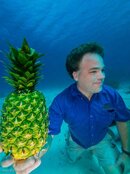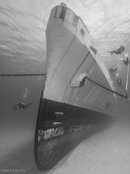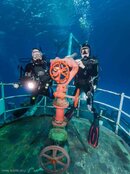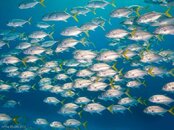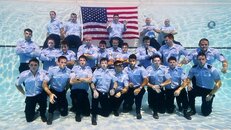And lastly, and most disappointingly, the minimum focus distance is terrible ! I need to be like a metre (3feets) away from the subject to safely focus. at 14mm its worse than at 7mm. My dome is the subal 4" and not sure if the placement of lens inside is then wrong, the done is too small, or what ? at air I get much much closer minimum focus distance.
// Cheers, Markku
The 7-14mm focuses closer at 7mm than at 14mm. I measure a minimum focusing distance (in air) of about 7" at 7mm, 8" at 14mm, less than the 9.84" (25cm) listed by Panasonic.
So you should be able to focus on something just inches from the front of the dome, as long as the focus point is in the center of the frame.
However, if you are trying to focus on something towards the corners, or use a large focusing point, I can see how the camera encounters problems.
When using a dome port the lens focuses on a virtual image some distance behind the port. This virtual image is curved (same shape as the dome), so the corners are much closer than the center. This is also why sharp corners are so tricky to achieve when using a dome port.
The smaller the dome, the steeper the curvature. 4" is a very small dome. So I can see how the camera could encounter problems focusing.
Another thing is I don't think it's physically possible to correctly position a 4" dome in front of the Panasonic 7-14mm lens. I measure the entrance pupil of the 7-14mm lens to be about 2.5" inches from the focal plane (imaging sensor). That means the front of the 4" subal dome must be approx 4.5" inches (2.5" + 2" dome radius) from the sensor in order to be correctly positioned. And I don't see how the dome can be positioned that close without banging into the built-in lens hood. Not sure how that affects focus, but for sure it's going to affect corner sharpness. Do you use an extension ring with this port?
---------- Post Merged at 05:26 PM ---------- Previous Post was at 05:04 PM ----------
The six inch Nauticam dome for the 7-14 zoom has a port equal to the curve of about a 230mm dome.
I think you are right. I did some crude measurements on mine. It does indeed look like it is a section of a 9" dome. Which would be great if the dome was correctly positioned. But from what I can tell the port is too short, meaning too close to the lens. As I mentioned above, the entrance pupil of the 7-14mm lens is about 2.5" from the focal plane, which means the front of the 9" dome would have to be positioned 2.5" + 4.5" = 7" in front of the sensor. I measure roughly 6", so it's an inch short.
This is all according to this WetPixel article:
http://wetpixel.com/i.php/full/proper-dome-size-and-placement/
Btw, I tried contacting Nauticam regarding this and never got any good answer. I can't figure out why they wouldn't position it correctly when they went through all the trouble of making a dedicated port. I just got mine and haven't taken it into the water yet, but inproper positioning would explain some of the reports of soft corners with this dome.
The Panasonic 7-14mm should be an excellent lens for underwater use. It's sharp, it focuses very close, 7" or so at 7mm, much closer than the listed spec, and due to the smaller sensor you have a two-stop depth-of-field advantage over full frame. But if it's not correctly positioned, what's the use?
- Fabian
---------- Post Merged at 05:43 PM ---------- Previous Post was at 05:04 PM ----------
Sorry Phil, my fault. Let me try a bit clearer:
The 7-14 lens, when used for really close focus has blurry corners on land, domes might make it worse, but it is there already.
The reason appears to be because of a physics issue of the lens having a curved field of focus when really close, a known issue with flat field, really wide angle lens. Corners will look the worse, because they are the farthest away.
Fish eye lens do not have this issue.
Zooming out will make it go away, but you obviously loose all that lovely wide angle. Being farther away also makes it go away.
Bottom line, if you bought the lens to do really close, really wide angle, it sucks (unless the objects in view fall along a three dimensional curved space.
Oh, and it is very easy to demonstrate.
PS I still really like the lens.
Stopping down will reduce it, but not completely
And the engineer in me can tell you that the field curvature is actually a good deal more than half corrected(meaning the curve is not as bad as it could be), and is an unavoidable byproduct of the lens design. This is not the only lens with this issue.
Not sure I understand this. When using a dome port you want to have field curvature. This is because the virtual image created by the dome is also curved. So if the lens focuses closer towards the corners, it's easier to get the corners sharp under water. And my understanding is that one of the reasons fisheye lenses are so popular for underwater use is because they tend to have a large amount of field curvature.
- Fabian




